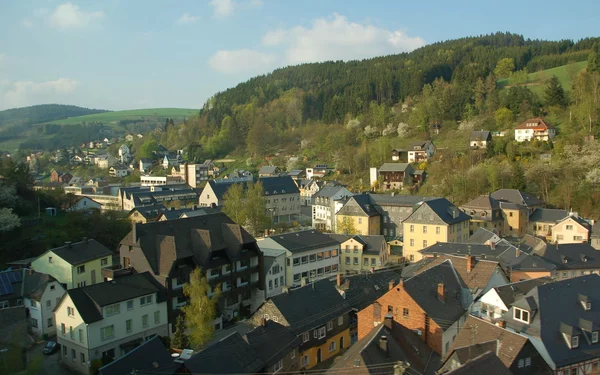Ludwigsstadt as the home of slate
Experience slate in Ludwigsstadt! On our hike through the low mountain range, you will discover the history of the "blue gold" and learn more about the mining and processing of slate.
Ludwigsstadt
4 h
4 km
If you are travelling in the German low mountain ranges, you will often see roofs covered in slate and exterior walls clad in black tiles. Slate is a much-used building material here because it is extremely weather-resistant, offers good thermal insulation and is easy to work with. What's more, grandma and grandpa learnt to read and write on slate. In Ludwigsstadt, you can find out where the slate comes from and how it was quarried and processed. So let's set off on the trail of slate.
A hiking tour for nature lovers and explorers
Start and end station
Bahnhof Ludwigsstadt
4 km / 4 Stunden
Bahnhof Ludwigsstadt
Our tip: Please make sure to check your train connection and the expected capacity before you start your journey.
Schedule
Tour starts on Bahnhof Ludwigsstadt
Direction
The path leads along Bahnhofstraße to a pedestrian bridge over the railway tracks. From there, it continues along a path that first leads past fields and then into the forest. As part of the Franconian Forest, the Rennsteig region is a hiker's paradise. After approx. 1.7 kilometres, you reach the geotope "Oertels Dachschieferbruch".
Geotope "Oertels roof slate quarry"
From the edge of the former slate quarry, you can take a look at the history of the earth. An information board explains the geological context. You learn that the sediments were deposited around 350 to 360 million years ago. However, the normal layer sequence of the rocks - younger ones lie on top of older ones - is reversed here: the reason is the extreme folding of the rock layers during the formation of the mountains.
A young mining engineer named Alexander von Humboldt was also interested in this phenomenon in 1792. He travelled around the region, which at the time belonged to Prussia, to explore mineable mineral resources. The "blue gold", which slate had been regarded as since the Middle Ages, seemed to him to be worth mining here on a large scale.
It was years before many small open-cast quarries were replaced by lucrative large-scale quarries. In 1849, the entrepreneur Karl Oertel took over some of these small quarries and by 1890 had grown them into the largest open-cast slate mine on the European continent. The construction of the railway line contributed significantly to the expansion of slate production.
The "Oertels Dachschieferbruch" geotope was awarded the "Bavaria's most beautiful geotopes" seal of approval.
Every year on the third Sunday in November, the "Day of the Geotope" takes place throughout Germany.
Direction
From the roof slate quarry, a forest path leads down to the Trogenbach stream. Follow Kehlbachstraße and later Rosengasse back to Ludwigsstadt. The path leads past the "Gasthof am Trogenbach" and the "Torpeter" restaurant, both of which tempt you with genuine Thuringian dumplings. Cross the railway tracks once more and you have reached the market square.
The old town hall
The imposing half-timbered building of the Old Town Hall stands on the edge of the market square. It was built at the end of the 1740s. As befits the region, the mansard roof of the town hall is also covered in slate. A ridge turret with bell, clock and weather vane testifies to its dignity as a town hall.
The town hall, which is no longer open to the public, is the starting point for many hikes through the Franconian Forest.
However, the Old Town Hall is no longer the seat of Ludwigsstadt's town council. This is located just round the corner at Lauensteiner Str. 1.
Lauensteiner Str. 1
96337
Ludwigsstadt
Direction
On Lauensteiner Straße, it is about 500 metres to the next highlight of the tour - the Slate Museum.
German Slate Museum
The German Slate Museum offers a comprehensive presentation of slate production from simple domestic trades to industrial production. Historical artefacts are used to show the work in the slate quarry and in the splitting huts. You can marvel at the fact that children all over the world learnt to write on slates from Ludwigsstadt. Deliveries were made to Eastern Europe, Asia, Africa and America. A good 36 per cent of the world market was served by the Ludwigsstadt blackboards. The introduction of paper exercise books in the 1960s ended the era of slates.
The German Slate Museum is a hands-on museum. In a historical classroom, you can try out for yourself what writing on slates felt like. If you like, you can buy a slate in the museum.
Lauensteiner Straße 44
96337
Ludwigsstadt
Tour ends on Bahnhof Ludwigsstadt
Direction
It is only a few steps from the Slate Museum to the railway station.







